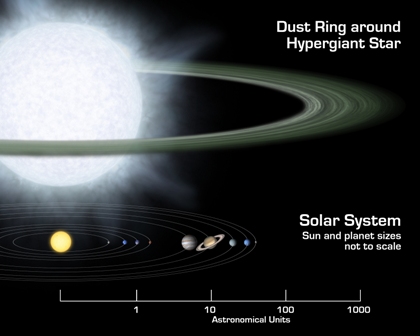
Artist's rendering compares size of a hypothetical hypergiant star and its surrounding dusty disk to that of our solar system.n

Planets in Strange Places
By Trudy E. Bell
Red star, blue star, big star, small star-planets may form around virtually any type or size of star throughout the universe, not just around mid-sized middle-aged yellow stars like the Sun. That's the surprising implication of two recent discoveries from the 0.85-meter-diameter Spitzer Space Telescope, which is exploring the universe from orbit at infrared (heat) wavelengths blocked by the Earth's atmosphere.
At one extreme are two blazing, blue "hypergiant" stars 180,000 light-years away in the Large Magellanic Cloud, one of the two companion galaxies to our Milky Way. The stars, called R 66 and R 126, are respectively 30 and 70 times the mass of the Sun, "about as massive as stars can get," said Joel Kastner, professor of imaging science at the Rochester Institute of Technology in New York. R 126 is so luminous that if it were placed 10 parsecs (32.6 light-years) away-a distance at which the Sun would be one of the dimmest stars visible in the sky-the hypergiant would be as bright as the full moon, "definitely a daytime object," Kastner remarked.
Such hot stars have fierce solar winds, so Kastner and his team are mystified why any dust in the neighborhood hasn't long since been blown away. But there it is: an unmistakable spectral signature that both hypergiants are surrounded by mammoth disks of what might be planet-forming dust and even sand.
At the other extreme is a tiny brown dwarf star called Cha 110913-773444, relatively nearby (500 light-years) in the Milky Way. One of the smallest brown dwarfs known, it has less than 1 percent the mass of the Sun. It's not even massive enough to kindle thermonuclear reactions for fusing hydrogen into helium. Yet this miniature "failed star," as brown dwarfs are often called, is also surrounded by a flat disk of dust that may eventually clump into planets. (Note: This brown dwarf discovery was made by a group led by Kevin Luhman of Pennsylvania State University.)
Although actual planets have not been detected (in part because of the stars' great distances), the spectra of the hypergiants show that their dust is composed of forsterite, olivine, aromatic hydrocarbons, and other geological substances found on Earth.
These newfound disks represent "extremes of the environments in which planets might form," Kastner said. "Not what you'd expect if you think our solar system is the rule."
Hypergiants and dwarfs? The Milky Way could be crowded with worlds circling every kind of star imaginable-very strange, indeed.
Keep up with the latest findings from the Spitzer at www.spitzer.caltech.edu/ . For kids, the Infrared Photo Album at The Space Place ( spaceplace.nasa.gov/en/kids/sirtf1/sirtf_action.shtml) introduces the electromagnetic spectrum and compares the appearance of common scenes in visible versus infrared light.

Artist's rendering compares size of a hypothetical hypergiant star and its
surrounding dusty disk to that of our solar system.n
This article was provided by the Jet Propulsion Laboratory, California Institute of Technology, under a contract with the National Aeronautics and Space Administration.
All content is the responsibility of LUNAR.
If you have comments or suggestions regarding these web pages,
please contact the 
Copyright © 1992 - 2025 LUNAR